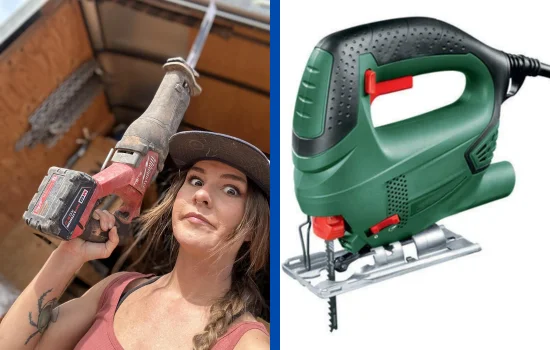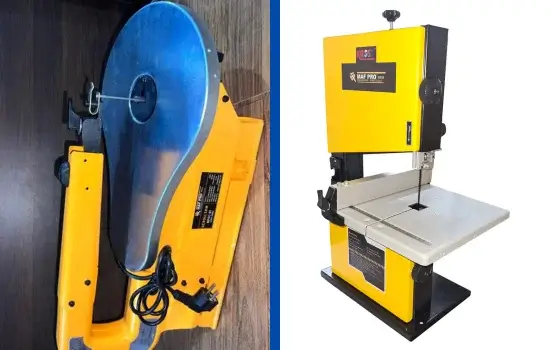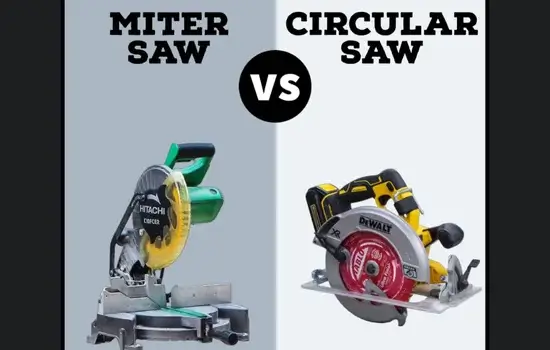When it comes to cutting tools for DIY enthusiasts, contractors, and woodworkers, two popular options are the reciprocating saw and the jigsaw. Though both tools rely on a reciprocating (back-and-forth) motion of the blade, they serve different purposes and are optimized for specific applications. Knowing the differences between them can help you choose the right saw for your projects.
This article will cover the functionality, unique features, and applications of reciprocating saws and jigsaws, as well as provide a comparison table to highlight their key differences.
The Definitions of Reciprocating Saw and Jigsaw
Reciprocating Saw
A reciprocating saw, often referred to as a “Sawzall” (a popular brand name), is a high-powered saw primarily used for demolition work. Known for its ability to cut through tough materials like wood, metal, drywall, and even masonry, the reciprocating saw features a long, exposed blade that moves back and forth rapidly, allowing it to cut through various materials with ease.
Jigsaw
A jigsaw is a more precise tool used for making detailed cuts. Unlike the rougher reciprocating saw, a jigsaw is primarily designed for cutting intricate shapes and patterns, especially in wood. It has a narrower, vertically-oriented blade that allows for curved and detailed cuts, making it ideal for woodworking, crafting, and other projects requiring precision.
Key Differences Between Reciprocating Saw and Jigsaw
| Feature | Reciprocating Saw | Jigsaw |
|---|---|---|
| Primary Function | Demolition and rough cuts | Precision and detailed cuts |
| Blade Motion | Horizontal, back-and-forth motion | Vertical, up-and-down motion |
| Cutting Direction | Primarily straight | Curved, straight, bevel, and intricate cuts |
| Material Suitability | Wood, metal, drywall, masonry | Wood, plastic, light metal |
| Portability | Highly portable, designed for rough sites | Portable and lightweight |
| Cutting Precision | Low, designed for quick cuts | High, ideal for intricate and precise cuts |
| Power Requirement | High-powered, typically cordless or corded | Medium to low-powered, often corded |
| Applications | Demolition, pruning, pipe cutting | Woodworking, cabinetry, craftwork |
| Safety Features | Blade guard, vibration control | Blade guard, dust blower |
| Cost | Mid-range to high, depending on power | Low to mid-range, with some high-end models |
Detailed Comparison of Reciprocating Saw and Jigsaw
1. Purpose and Applications
- Reciprocating Saw: A reciprocating saw is built for heavy-duty, fast-paced demolition work. It’s commonly used in construction and remodeling projects where precision is secondary to speed and power. This saw is perfect for jobs that require cutting through tougher materials like studs, metal pipes, drywall, and even brick. It’s also popular for outdoor tasks such as pruning trees, thanks to its ability to cut through branches and roots with ease.
- Jigsaw: A jigsaw, in contrast, is a precision tool optimized for intricate cuts. Its narrow blade allows it to cut curves, circles, and patterns, making it a favorite among woodworkers, cabinet makers, and artists. Jigsaws are ideal for woodworking and craft projects where the user needs control and flexibility. They are also suitable for lighter materials, such as plywood, plastic, and thin metals, though they lack the power for thicker or tougher materials.
2. Blade Motion and Cutting Style
- Reciprocating Saw: The blade on a reciprocating saw moves in a horizontal back-and-forth motion. This rapid, aggressive motion makes the reciprocating saw ideal for rough cuts rather than precision work. The saw’s handle design allows for maneuverability in various positions, making it suitable for working in tight spaces or cutting from unusual angles.
- Jigsaw: A jigsaw’s blade moves vertically in an up-and-down motion, which is gentler and allows for precision. The blade is narrow and flexible, and many jigsaws come with an orbital setting, allowing users to adjust the aggressiveness of the cut. This control makes it easier to follow curves and intricate shapes in the material.
3. Cutting Precision and Direction
- Reciprocating Saw: Designed for demolition, the reciprocating saw isn’t known for its precision. It is most effective for rough cuts and is less accurate when cutting straight lines or curves. Its power and speed make it perfect for cutting through materials quickly, but it’s not suited for tasks that require fine detail.
- Jigsaw: Precision is the jigsaw’s specialty. It can make straight cuts, curved cuts, and even beveled cuts with high accuracy. Some jigsaws also have laser guides or guide rails, which help keep the cut lines straight and neat. This precision makes the jigsaw perfect for projects requiring detailed cuts and finishes.
4. Material Suitability
- Reciprocating Saw: Reciprocating saws are versatile in terms of material compatibility, with blades available for wood, metal, masonry, and even ceramic. This adaptability makes them useful across a range of demolition and construction tasks, especially when cutting through metal pipes, drywall, nails, or even bricks.
- Jigsaw: A jigsaw is most effective when used on lighter materials, such as wood, plywood, and plastic. It can cut through thin metal with the right blade, but it is not built for dense or thick materials. The finer blade teeth are optimized for clean, detailed cuts, which are not needed in heavy-duty applications.
5. Power Requirements and Efficiency
- Reciprocating Saw: Reciprocating saws are generally high-powered and come in both corded and cordless models. Corded models provide consistent power for long projects, while cordless versions offer portability for remote or outdoor work. They are typically more power-intensive than jigsaws, which is necessary for cutting dense materials.
- Jigsaw: Jigsaws are less power-intensive and are generally available in corded models. Some cordless jigsaws are available, but they are usually limited in power. The jigsaw’s lower power requirement allows for precision work without causing damage to delicate materials.
6. Portability and Design
- Reciprocating Saw: Reciprocating saws are designed to be highly portable and rugged, making them perfect for on-site work. Their compact design allows them to reach into tight spaces, and they are comfortable to use in various positions. The pistol-grip or D-handle style allows for a firm grip, which is essential when cutting tough materials.
- Jigsaw: Jigsaws are also portable and lightweight, though they are typically used on a stable surface for better control. Their compact design allows for precision cutting, and they can be used both on-site and in a workshop. Jigsaws are typically operated in a more controlled manner, making them suitable for hobbyists, woodworkers, and DIYers who require accurate cuts.
7. Safety Features
- Reciprocating Saw: Safety features on reciprocating saws often include a blade guard and an anti-vibration mechanism, as they produce substantial vibrations during use. Many models also come with an electronic brake, which stops the blade quickly after releasing the trigger to enhance safety during demolition tasks.
- Jigsaw: Jigsaws include a blade guard, which protects the user from accidental contact with the blade. Many jigsaws also come with a dust blower to keep the cutting line visible, enhancing precision. The low-vibration mechanism in jigsaws makes them safer to use for detailed work, as users have more control over the blade.
8. Cost Considerations
- Reciprocating Saw: Reciprocating saws are generally mid-range to high in price, with cordless models being more expensive than corded ones. The cost often depends on the power, battery capacity, and additional features like electronic brakes or variable speed settings. High-end models may also include vibration control and ergonomic designs for prolonged use.
- Jigsaw: Jigsaws range from budget-friendly to high-end, depending on the brand, features, and power. Basic jigsaws are quite affordable, while advanced models with features like orbital settings, laser guides, and dust blowers can be more expensive. Since jigsaws are used for more precise work, investing in a high-quality jigsaw can improve results significantly.
Pros and Cons of Reciprocating Saw and Jigsaw
Reciprocating Saw Pros:
- Powerful and suitable for heavy-duty tasks
- Versatile and able to cut through a variety of materials
- Ideal for demolition, remodeling, and outdoor cutting tasks
- Highly portable and easy to maneuver in tight spaces
Reciprocating Saw Cons:
- Lacks precision, not suitable for detailed cuts
- Produces more vibration, which may cause fatigue
- Limited in cutting curves and intricate patterns
Jigsaw Pros:
- Excellent for making precise, intricate cuts
- Can cut curves, circles, and bevels with accuracy
- Lightweight and easy to handle, ideal for woodworking
- Available in affordable options for beginners and DIYers
Jigsaw Cons:
- Not suitable for heavy-duty materials or thick metals
- Less powerful than reciprocating saws
- Slower when cutting through dense materials
Choosing Between a Reciprocating Saw and a Jigsaw
Your choice between a reciprocating saw and a jigsaw largely depends on the specific tasks you plan to undertake:
- If your work involves demolition, remodeling, or cutting through tough materials like metal or masonry, a reciprocating saw is the ideal choice. Its power and aggressive cutting motion make it invaluable in construction and demolition.
- If you need to make precise cuts in wood, plastic, or other light materials, or if you plan to do intricate woodworking or craft projects, a jigsaw is the right tool. Its ability to cut curves and detailed shapes makes it a versatile choice for anyone working on finer projects.
For those who need both rough and precise cutting capabilities, having both a reciprocating saw and a jigsaw can cover all your cutting needs.
Conclusion
Both reciprocating saws and jigsaws bring unique strengths to the table. By understanding their differences, applications, and key features, you can make an informed decision that aligns with your project requirements, ensuring efficiency, precision, and satisfaction in your work.


